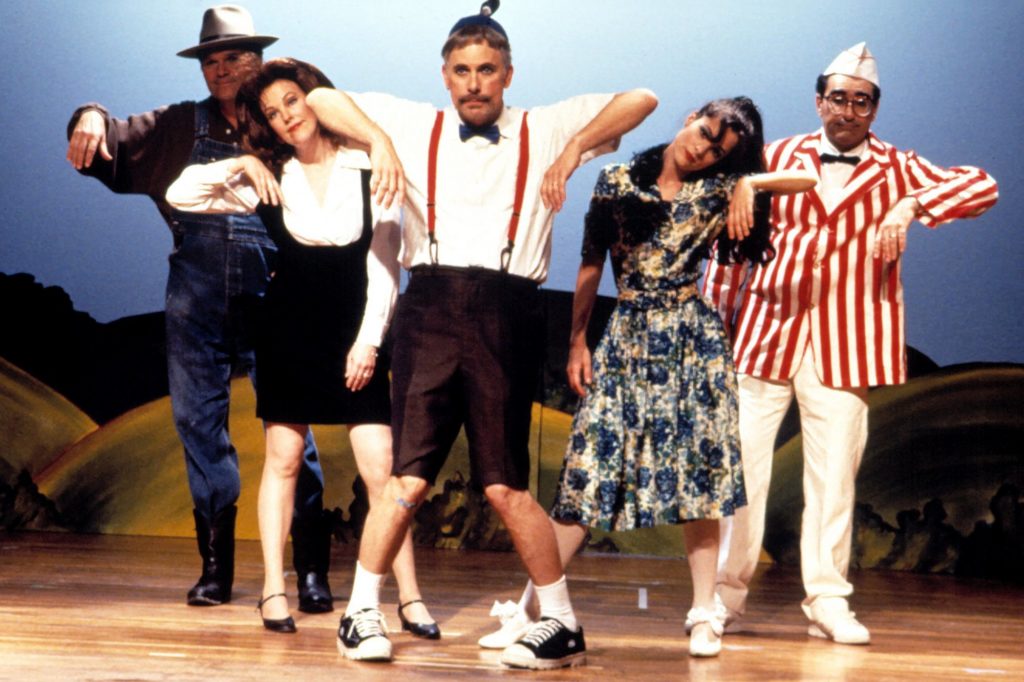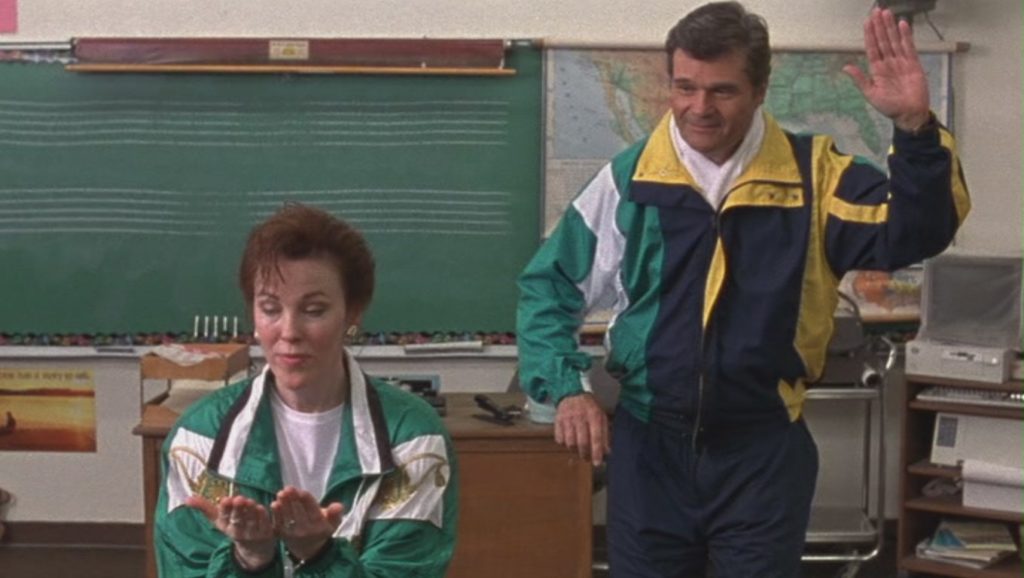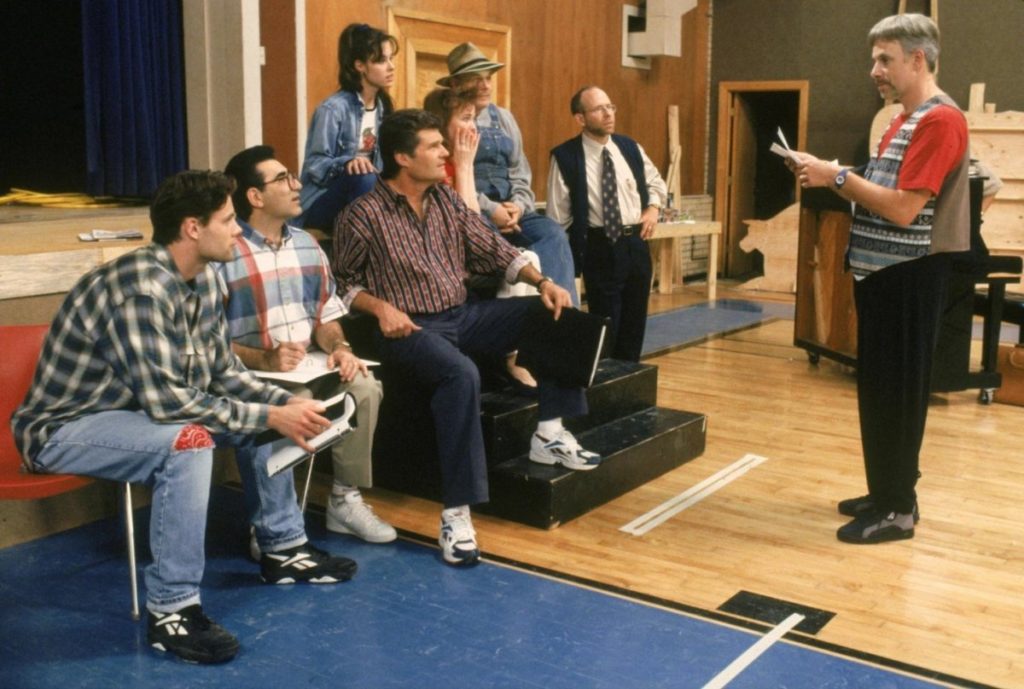| Lucas Vonasek |

Waiting For Guffman plays at the Trylon Cinema from Monday, June 19 through Tuesday, June 20. Visit trylon.org for tickets and more information.
Nothing ever happens in small towns. If you’ve never lived in one, it’s difficult to imagine what they can offer that a city cannot, whether that is a burgeoning nightlife scene, diverse cuisine options, or that alluring energy that only a hip metropolis can offer. However, any town regardless of size is made of two things: people and dreams. Led by the direction of Christopher Guest and brought to life by a powerhouse ensemble of top-tier comedic performers, Waiting for Guffman offers a peek inside both the people and the dreams of Blaine, Missouri with a love letter to small town community theater by way of this iconic mockumentary.
Guffman undoubtedly zeroes in on the absurdity that any art or theater community, regardless of size, can exhibit and attest to, but it also highlights the heart and pride of a community rallying behind a production that they identify with. Guest does this is in three acts: The Audition, The Rehearsal, and The Show.
“We found them and that’s the wonderful thing”
One of the beautiful things about community theater is that it offers an opportunity for anyone to pursue long-held dreams. The audition scene within Guffman illuminates two representations of said dreams. Off-off-off-off-off Broadway castaway Corky St. Clair (Guest) is the director of Red, White, and Blaine and can do no wrong in the eyes of the Blaine residents, but we as viewers can see that there are no strong choices. He witnesses the extremes of a given audition process.

Local theater power couple Ron (Fred Willard) and Sheila (Katherine O’Hara) Albertson headline the audition. On one hand, they represent the false bravado that can be ever-present in any given community theater. On the other hand, they also represent the resiliency of not letting a passion become dormant; something that even time or location cannot diminish. The iconic pair of Willard and O’Hara present them as incorrigible narcissists, but despite these self-appointed big fishes in a little Missouri pond, their dream is still valid and has every right to be pursued just like anyone else’s. Dr. Allan Pearl (Eugene Levy) is armed with voluminous eyebrows and an eagerness to finally try something he’s wanted for a very long time. He represents the raw talent and unpredictability that is present throughout any community, theatrical or otherwise. As an auditioner, Corky doesn’t know who may walk in the door. He knows a Ron and a Sheila will be there, but he also truly hopes for a Dr. Allan Pearl because community theater encourages someone who may have put their dreams on hold to finally go out for that production in a (hopefully) safe and supportive environment. It will always be beautiful when someone takes a chance on themselves for the first time or the hundredth time. A community theater can provide them a stage to do so.
“A wrastlin’ match between me and the muse of theater”
Every cast has a moment where they either become a collaborative and supportive unit or they miss the moment entirely, and they simply don’t come together. A dentist, two travel agents, a mechanic, and a Dairy Queen employee may have very little in common within their day-to-day lives, but the rehearsal sequence in Guffman highlights the delicate environment of self-expression and the power dynamics of the varying experience levels, and how both of those things can be forged together by unique events.

Dr. Pearl is experiencing a cavalcade of positive emotion that has been dormant for his entire life. The Albertsons can’t get their own egos out of the way, and Libby Mae Brown (Parky Posey) and Johnny Savage (Matt Keeslar) youthfully go along for the ride. However, they’re all in this together. They all attempt eclectic exercises designed to get them out of their shell and embrace vulnerability all the while falling short of critical components like knowing their lines or singing in the right key. The show is at a crisis point when Corky leaves abruptly. While the director brought them all together initially, it’s the cast who salvages the production. They band together and convince Corky to rejoin the musical. That is their moment where their collective dream lives on and the show survives. From then on, the cast gets closer and stronger as they all work toward the finish line that is opening night.
“This is the day of the show, y’all”
The buzz before a show is palpable. Audience members shuffle to their seats and luminaries hob-knob in hushed tones as everyone waits for the curtains to be open. Backstage bustles with energy—actors, stagehands, makeup artists, moving with purpose and constantly straddling the line of nervousness and excitement. Unfolding in Blaine’s quintessential small-town gymnasium-auditorium combination is Red, White, and Blaine. With a miniscule budget for props and costumes and too much stage makeup, St. Clair makes do and the audience eventually eats it up.
From the perspective of the actors, Red, White, and Blaine wasn’t a total success because a big theater executive didn’t show thus ending their Broadway pipedream. However, the town absolutely loved it because while it isn’t New York City, this is still Blaine’s Broadway. Failure cannot exist because no matter how the musical turned out, it was always going to be viewed as a success. The town gets to see their friends and family showcase their talents that they may have never been seen until then. They also get to see their town’s story being told by way of song and dance. While we as viewers know that the musical and the entire production lacks quality, it doesn’t matter. It doesn’t matter if a line is flubbed, a song is flat, or the acting is atrocious. That’s not the point. The only thing that matters about this entire production from beginning to end is that a story was shared and artistic expression was given a chance on a very small stage in a very small town.
Every town big or small has stories to share and, while they may not be perfect and oftentimes not even accurate, community theaters like the one helmed by Corky St. Clair are just as important as any other theater troupe or stage out there. So, if you find yourself in a town that is different from yours and they have an original production advertised on a dimly light marquee, stop in. Why not? You might just be someone’s Guffman or you could keep on going with the assumption that nothing ever happens in small towns.
Edited by Olga Tchepikova-Treon
